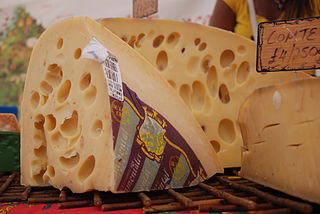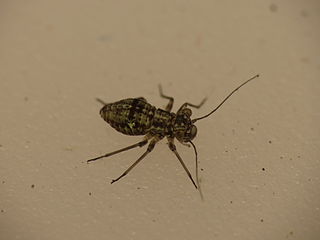
The palmate newt is a species of newt found in Western Europe, from Great Britain to the northern Iberian peninsula. It is 5–9.5 cm (2.0–3.7 in) long and olive or brown with some dark spots. The underside is yellow to orange, and the throat, unlike in the similar smooth newt, always unspotted. A dark stripe runs along the head and through the eyes. Breeding males develop a distinct filament on the end of their tail, strongly webbed hind feet, and a low, smooth crest on their back.

Emmental, Emmentaler, or Emmenthal is a yellow, medium-hard cheese that originated in the area around Emmental, in the canton of Bern in Switzerland. It is classified as a Swiss-type or Alpine cheese.

Southlake Moor is a 196.1 hectare biological Site of Special Scientific Interest near Burrow Mump and Burrowbridge in Somerset, notified in 1985.

Chroogomphus is a genus of mushrooms commonly known as pine-spikes or spike-caps based on their shape and because they are often found growing in association with pine trees. The genus is distributed throughout the Northern Hemisphere including North America, the Caribbean, Europe, and Asia.
Pluralibacter gergoviae is a Gram-negative, motile, facultatively-anaerobic, rod-shaped bacterium. P. gergoviae is of special interest to the cosmetics industry, as it displays resistance to parabens, a common antimicrobial agent added to cosmetic products.
Bracteacoccus helveticus is a species of green algae, in the family Bracteacoccaceae. Under its synonym Cryococcus helveticus, it was the only species in the genus Cryococcus.

Cronobacter is a genus of Gram-negative, facultatively anaerobic, oxidase-negative, catalase-positive, rod-shaped bacteria of the family Enterobacteriaceae. Several Cronobacter species are desiccation resistant and persistent in dry products such as powdered infant formula. They are generally motile, reduce nitrate, use citrate, hydrolyze esculin and arginine, and are positive for L-ornithine decarboxylation. Acid is produced from D-glucose, D-sucrose, D-raffinose, D-melibiose, D-cellobiose, D-mannitol, D-mannose, L-rhamnose, L-arabinose, D-trehalose, galacturonate and D-maltose. Cronobacter spp. are also generally positive for acetoin production and negative for the methyl red test, indicating 2,3-butanediol rather than mixed acid fermentation. The type species of the genus Cronobacter is Cronobacter sakazakii comb. nov.

Didier Ruef is a Swiss documentary photographer best known for his portrayal of man and waste, recycle and sustainability, Africa, man and animals, Swiss alpine farmers and contemporary Switzerland.
Lactobacillus helveticus is a lactic-acid producing, rod-shaped bacterium of the genus Lactobacillus. It is most commonly used in the production of American Swiss cheese and Emmental cheese, but is also sometimes used in making other styles of cheese, such as Cheddar, Parmesan, Romano, provolone, and mozzarella. The primary function of L. helveticus culture is to prevent bitterness and produce nutty flavors in the final cheese. In Emmental cheese production, L. helveticus is used in conjunction with a Propionibacterium culture, which is responsible for developing the holes through production of carbon dioxide gas.

Eomys is an extinct genus of eomyid rodent from the late Oligocene of France, Germany, Spain, and possibly Turkey. The species Eomys quercyi is the earliest known gliding rodent.

Lissotriton is a genus of newts native to Europe and parts of Asia Minor. As most other newts, they are aquatic as larvae and during breeding time but live in terrestrial, humid environments over the rest of the season.

Sierra de la Demanda is a mountain sub-range situated in the northern Iberian Peninsula.
Mesopsocus unipunctatus is a species of barklouse found across the Holarctic. It is a member of the Mesopsocidae family. It is a generalist that occurs on branches of deciduous and coniferous trees, as well as lower hedgerows and shaded meadows.

Mesopsocus immunis is a species of Psocoptera from the Mesopsocidae family that can be found throughout Western Europe, and Hungary.
Mesopsocus blancae is a species of Psocoptera from the Mesopsocidae family that is endemic to Spain.
Mesopsocus duboscqui is a species of Psocoptera from the Mesopsocidae family that can be found in Cyprus, France, Greece, Italy, Slovenia, and Spain.
Mesopsocus fuscifrons is a species of Psocoptera from the Mesopsocidae family that can be found in North Macedonia and Kaliningrad, Russia.
Mesopsocus graecus is a species of Psocoptera from the Mesopsocidae family that can be found in Cyprus, Greece, and North Aegean islands.

Mesopsocus is a genus of middle barklice in the family Mesopsocidae. There are more than 60 described species in Mesopsocus.
Pluralibacter is a genus of Gram negative bacteria from the family of Enterobacteriaceae. The genus consists of two species, P. gergoviae and P. pyrinus. Both species were originally classified in the genus Enterobacter, but were reclassified into the novel genus Pluralibacter in 2013.










